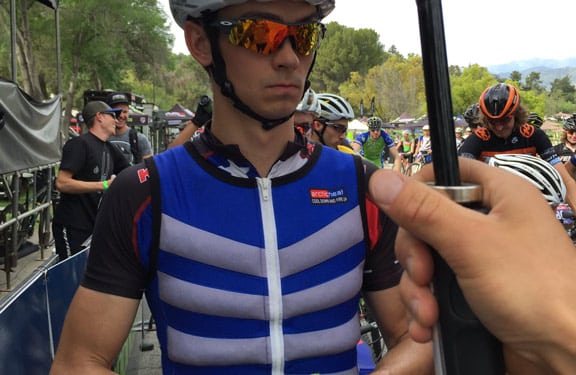
Optimizing Your Pre-Event Warmup for Hot Weather
In hot weather athletes face a conundrum. A pre-event warmup is designed to increase muscle core temperature, start the body’s cooling processes, and activate energy systems. But elevating core temperature too high diminishes performance dramatically. So how do you warm up when it’s hot out?
Here’s a step-by-step guide to walking the fine line between activating your body for a great performance and hurting your performance through overheating.
Precool/Preload
This is going to seem counterintuitive, but cooling down before you warm up can be beneficial before a hot-weather event. But even before that, I recommend consuming a hyper hydrator. I use a high sodium content sports drink the evening before or the morning of a hot-weather ride. The high sodium content (sodium citrate and bicarbonate) expands plasma volume, which primes your body’s cooling system by providing more fluid for sweat. Then, before getting on the bike for your warmup try to keep yourself cool with air conditioning in the car or a building, and staying in the shade.
[blog_promo promo_categories=”” ids=”coaching” /]What about cold beverages? There’s some debate in the sports science community about when cold beverages and ice slurry drinks should be consumed. When you’re working hard these beverages may actually confuse the body into thinking you don’t need to sweat as much, but they seem to be effective for helping athletes control core temperature before a warmup and between your warmup and your event.
Warm up
The biggest change to your warmup routine in the heat is to dramatically reduce its duration. It’s pretty common for a warmup routine to be 45-60 minutes, but in a hot environment that should be cut down to about 20 minutes. You still need to spend some time at lactate threshold and throw in a few high-intensity efforts to activate the processes related to producing and processing lactate, but you want to do as little as possible to achieve those goals. Reducing your warmup to 5 minutes of spinning, 5-10 minutes at LT, and two 1-2 minute VO2 max efforts will typically get the job done. In contrast, a long warmup is likely to generate more heat than you’ll be able to compensate for, even with an ice vest, ice socks, and cold beverages.
The nature of your event also plays a role in your hot weather warmup. If your event is going to start out relatively slow, like a road race, then you can minimize the warmup activities and focus more on staying cool. If the event is going to start hard, like a criterium or cross-country mountain bike race, then it’s still important to activate your energy systems and lactate processing systems.
[blog_promo promo_categories=”camp” ids=”” /]
Cool Down Briefly Post-Warmup
One of the departures from the old-school warmup strategies is to actively cool down again after you get off the trainer or after warming up on the road or trail. Typically, and especially in cold weather warmups, you would want to stop your warmup routine and go directly to the start line. In this hot weather strategy you stop earlier so you can cool down with an ice vest, dousing your clothing with water, and/or drinking a cold drink or ice slurry drink. But here is where you’re going to be walking a fine line. After riding your warmup routine your muscle temperature and core temperature are elevated, and if you wait too long between your warmup routine and your start your body can become a heat sink. You can actually heat up even more, which would be bad. To avoid this you need to go from your active warmup directly to active cooling for about 10 minutes before going to the start line.
► Free Cycling Training Assessment Quiz
Take our free 2-minute quiz to discover how effective your training is and get recommendations for how you can improve.
Go to the Startline
If you’re going to be standing on the start line for a long time before you start, as if often the case with mountain bike races and criteriums, you’re going to be standing still with minimal airflow in the sun. In this scenario, try to go to the line wearing an ice vest or with ice socks in your jersey pockets and/or tucked into the neck of your jersey between your shoulder blades. These things often require some support, someone to hand off your cooling devices to. If you don’t have that kind of support, soaking your jersey is an effective self-supported method.
One of our top mountain bike coaches, Adam Pulford, is also the Team Director for Team Sho-Air and he has been employing these strategies with the team before hot-weather races around the country. The focus on staying cool and minimizing heat buildup during riders’ warmup routines has paid off. The riders are ready for action right from the starting gun, and keeping their core temperatures under control enables them to start faster, get to the front of the race, and stay there.
[blog_promo promo_categories=”product” ids=”” /]You can’t control the weather, but when you proactively take steps to balance your need to activate your energy systems, start the process of producing and dealing with lactate, and keep your core temperature from rising out of control, you can have a lot of control over your hot weather performance.
► FREE Mini-Course: Learn How to Maximize Your Limited Training Time
Learn step-by-step how to overcome limited training time and get faster. Walk away with a personalized plan to increase your performance.

Comments 1
Do you recommend using a lactate starter like SportLegs, or avoiding in hot weather? I feel I do better with them and a few specialized electrolytic enhancing capsules.